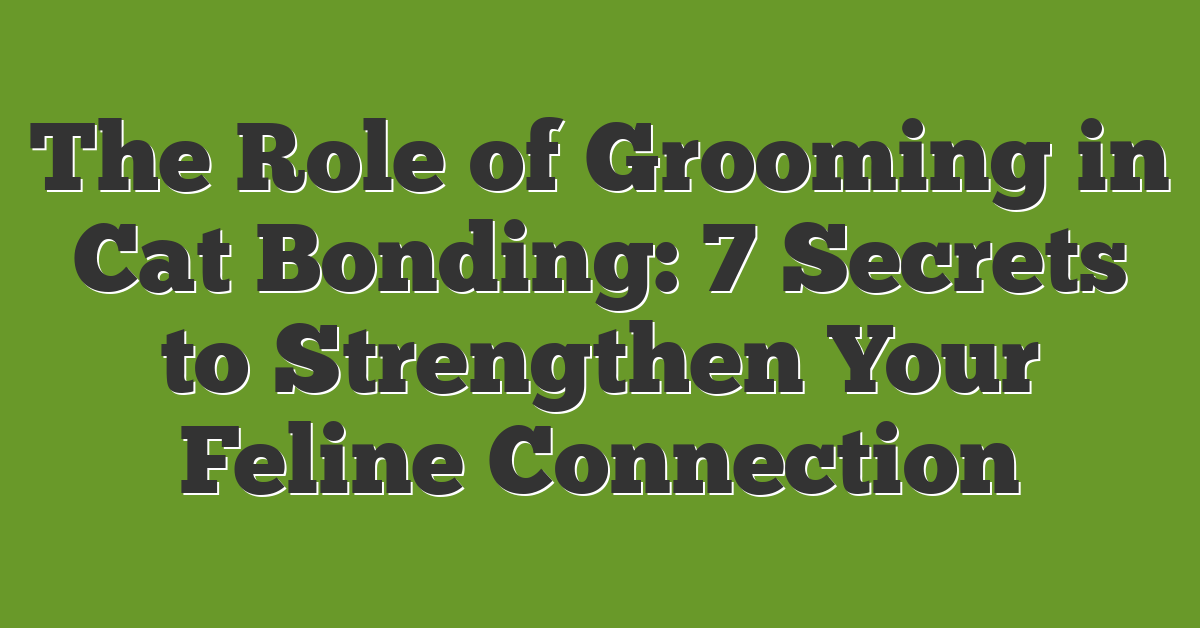As a cat lover, I’ve always been intrigued by the unique ways our feline friends connect with us and each other. One behavior that stands out is grooming. It might seem like just a routine activity, but grooming plays a crucial role in strengthening bonds.

When cats groom themselves or each other, they’re not only keeping clean but also sharing trust and affection. This simple act helps build deeper relationships and fosters a sense of security. By understanding the importance of grooming, we can better appreciate the subtle ways our cats communicate and connect.
The Importance of Grooming in Cat Bonding
Grooming is key to forming strong connections with my cat and other felines. It’s more than just keeping clean; it builds trust and affection.
Enhancing Social Connections
When I groom my cat, it deepens our bond and shows my love. Cats groom each other to display trust and friendship. This mutual grooming creates a sense of community and lowers stress levels. Regular grooming sessions encourage positive interactions and strengthen relationships.
Promoting Physical Health
Grooming keeps my cat’s fur shiny and free from tangles. It helps spot skin problems early, like parasites or allergies. Regular brushing reduces hairballs and improves digestion. Additionally, grooming stimulates blood circulation, promoting overall health and well-being.
Understanding Grooming Behaviors
Grooming is more than just keeping clean for cats. It plays a key role in how they connect with each other and with their owners.
Mutual Grooming Among Cats
When cats groom each other, it’s called allogrooming. I see it as a sign of trust and friendship. Cats use their tongues to clean each other’s fur, removing dirt and loose hairs. This behavior strengthens their social bonds and creates a sense of community. If one cat grooms another, it shows they feel safe and comfortable together. Mutual grooming also helps reduce stress and prevent conflicts within a group.
Self-Grooming Practices
Cats spend a lot of time grooming themselves, known as alloselfgrooming. I notice that self-grooming keeps their coats shiny and free from parasites. It helps them stay flexible and healthy by removing loose fur and dirt. When a cat grooms itself, it also regulates body temperature and relieves stress. Regular self-grooming can signal that a cat feels secure in its environment. Plus, it allows them to maintain their personal hygiene without relying on others.
Grooming and the Human-Cat Relationship
Grooming plays a crucial role in how I connect with my cat. It deepens our bond and helps her feel safe.
Building Trust and Affection
When I groom my cat, she shows trust and affection. She purrs and leans into my touch. This mutual grooming strengthens our relationship and makes her feel loved. Regular grooming sessions help her relax and feel secure around me.
Establishing a Grooming Routine
Having a consistent grooming routine is important. I set aside time each day to brush her fur. This routine ensures she stays clean and comfortable. It also gives us quality time together, reinforcing our bond. A predictable schedule helps her feel safe and reduces stress.
Effective Grooming Techniques
Grooming helps me bond with my cat. I use specific methods to make our time together enjoyable.
Choosing the Right Tools
Selecting the right grooming tools makes a big difference. I use a slicker brush to remove loose fur and prevent mats. For long-haired cats, a comb helps detangle their coat. Nail clippers keep their claws trimmed safely. I also use grooming gloves to massage their skin and reduce shedding.
Best Practices for Bonding
Following best practices strengthens our connection. I start grooming in a quiet space to keep my cat calm. Watching their body language helps me know when to stop if they’re uncomfortable. Keeping a regular grooming schedule builds trust and routine. I reward my cat with treats and gentle praise to make grooming a positive experience.
Common Grooming Challenges
Even with regular grooming, some cats face challenges. Understanding these issues helps maintain their health and our bond.
Over-Grooming and Its Causes
Over-grooming happens when cats lick or comb their fur too much. It can cause bald spots and sore skin. Stress often leads to over-grooming, like changes in the home or loud noises. Allergies, parasites, and skin infections also make cats groom excessively. Boredom or lack of stimulation can cause cats to groom more to feel calm.
Addressing Grooming Issues
To handle grooming problems, I stick to a regular brushing routine. This helps remove loose fur and prevents mats. I create a calm environment to reduce my cat’s stress, using pheromone diffusers if needed. Checking for parasites and visiting the vet helps find any medical reasons for over-grooming. Providing plenty of toys and activities keeps my cat entertained and less likely to groom too much.
Conclusion
Grooming has truly opened my eyes to the deep connections we share with our feline friends. Watching my cat carefully tend to her fur and reciprocate my gentle brushing makes me feel closer than ever. It’s amazing how such simple actions can build trust and strengthen our bond.
Taking the time to groom not only keeps her healthy but also creates moments of calm and companionship. These quiet times together have become some of my favorite parts of the day. I encourage every cat owner to embrace grooming as a way to nurture their relationship and enjoy the unique ways our cats show their affection.
Seeing the positive impact grooming has on our cats reminds me how important it is to invest in these daily rituals. It’s a small effort that brings immense rewards in love and trust.
















